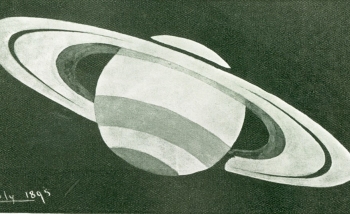“Once a decade or so, astronomers discover a new type of mysterious event in the universe,” says Perimeter Faculty member Kendrick Smith. “In the 1960s, pulsars were an unexpected mystery; in the ’70s, gamma-ray bursts were a surprise, and so on. In the 21st century, our mysterious surprise is the fast radio burst.”
The surprise first turned up in 2007, when astronomers combing archival data noticed something odd: an incredibly brief pulse of radio-frequency light that seemed to come from well outside the galaxy. It was faint – faint as a cellphone signal sent from the moon – but it clearly didn’t start out that way. Whatever produced the signal must have released as much energy in a few milliseconds as our Sun does over 80 years.
The hunt for more of these pulses – which were named “fast radio bursts” and came to be called FRBs – was on immediately. But over a decade of intensive search, only 25 more turned up. Puzzlingly, only one seemed to repeat.
With so few recorded events, physicists developed more FRB theories than they had FRB detections. With so little data, progress could only crawl forward. That all changed with the commissioning of a new telescope, the Canadian Hydrogen Intensity Mapping Experiment, or CHIME. Involving about 50 scientists from Perimeter, McGill, the University of Toronto, the University of British Columbia, and the National Research Council of Canada, and located in BC’s Okanagan Valley, CHIME is the first new Canadian telescope in decades.
“It was exciting,” says Smith, who holds the Daniel Family James Peebles Chair at Perimeter. “In a world full of huge international collaborations, CHIME is a small, Canada-only project. This was a chance to make Canada a leader in one of the hottest problems in astrophysics.”
CHIME’s strengths – and challenges – spring from its unusual design. Instead of the more common swivelling disks, CHIME has four half-cylinders running in parallel, each resembling a skateboarder’s halfpipe. While most telescopes turn to focus on the object under study, CHIME doesn’t focus at all. The half-pipes stare straight up at the sky, moving only because they are mounted to the most reliable of moving parts, the Earth itself. As the Earth turns, the telescopes sweep across the sky like a photocopy scanner sweeping a piece of paper. To speak analogously: where other telescopes use zoom lenses, CHIME is wide angle, and therefore it will record transient events, including FRBs, that other telescopes might capture only by chance.
That’s where the challenge kicks in. CHIME churns out a petabyte of data every single day. That’s 1,024 terabytes, or a million gigabytes, equivalent to more than 38 years of continuously binge-watching Netflix in HD. In all that data, somewhere, about once a day, should be the faint, brief flicker of an FRB.
Forget finding a needle in a haystack: this is like plucking a pebble from an avalanche. Making the challenge more difficult is the fact that the CHIME team has to search that data as it arrives, in real time. “It’s too much to save to disk, so you only get to look at it during a little window of time when it’s in memory,” explains Smith. “You need big supercomputers on site, doing real-time processing for every analysis we want to do – including FRBs.”
The team originally assumed that it would be impossible to process that magnitude of data so quickly. “We thought we would have 10 people working on it. We’d buy this gigantic farm of machines, with a huge power bill, and only search a subset of the data,” says Perimeter Associate Faculty member Ue-Li Pen, who is cross-appointed with the Canadian Institute for Theoretical Astrophysics.
Then they discovered some promising but little-used algorithms that could help speed up their search. “Kendrick got excited,” says Pen with a chuckle. “If it’s a nifty algorithm problem, that’s right up his alley.”
With a first PhD in math, a second in cosmology, and a stint as a software engineer in between, Smith’s revolutionary approach mixes physics, data analysis, statistics, and pure mathematics to find the signals in the incredible rush of data generated by new experiments like CHIME. It’s for this kind of work – “developing novel techniques to extract fundamental physics from astronomical data” – that Smith was recognized as one of the winners of the 2020 New Horizons in Physics Prize.
Leading a small Perimeter team that included computational scientist Dustin Lang, students Masoud Rafiei-Ravandi and Utkarsh Giri, and research assistant Maya Burhanpurkar, Smith developed several breakthrough algorithms for sorting and analyzing the CHIME data. He and his team then implemented this new mathematics as software. The result was an FRB search that ran a hundred times faster than anyone expected and turned the CHIME telescope into the world’s best FRB hunter. “We basically turned high-precision radio astronomy into a software problem,” Smith says.
The CHIME telescope took first light in the fall of 2017 and started spotting FRBs while still in its commissioning phase. In January 2019, the CHIME team captured global headlines – including the cover of Nature – with a first batch of 13 discoveries, including another repeater. In August, they announced a second, much larger batch that, perhaps most excitingly, contained eight more repeaters.
“We can find more FRBs in days than had been seen in years of intensive study,” says Smith. “It’s a game-changer.”
The discoveries injected jet fuel into the study of FRBs. For instance, the CHIME team is beginning to pick apart the differences between repeating FRBs and those that have not yet been observed to repeat. A breakthrough of understanding seems imminent.
“I think the upcoming year will be a really good one for FRBs,” said Victoria Kaspi, an astrophysicist at McGill University, in an interview with CBC News. Kaspi is a member of the CHIME collaboration and an expert on “radio transients” like FRBs. “Are we going to know the answer in a year’s time? I don’t know. Maybe. But I think we will have made significant progress in a year.”
With the pace of discovery picking up, the fast-unfolding field of FRBs has gone from a crawl to a gallop.
- With files from Stephanie Keating
Further exploration
About PI
Perimeter Institute is the world’s largest research hub devoted to theoretical physics. The independent Institute was founded in 1999 to foster breakthroughs in the fundamental understanding of our universe, from the smallest particles to the entire cosmos. Research at Perimeter is motivated by the understanding that fundamental science advances human knowledge and catalyzes innovation, and that today’s theoretical physics is tomorrow’s technology. Located in the Region of Waterloo, the not-for-profit Institute is a unique public-private endeavour, including the Governments of Ontario and Canada, that enables cutting-edge research, trains the next generation of scientific pioneers, and shares the power of physics through award-winning educational outreach and public engagement.
You might be interested in

Spiralling light from M87’s supermassive black hole reveals strong magnetic fields
November 8, 2023

